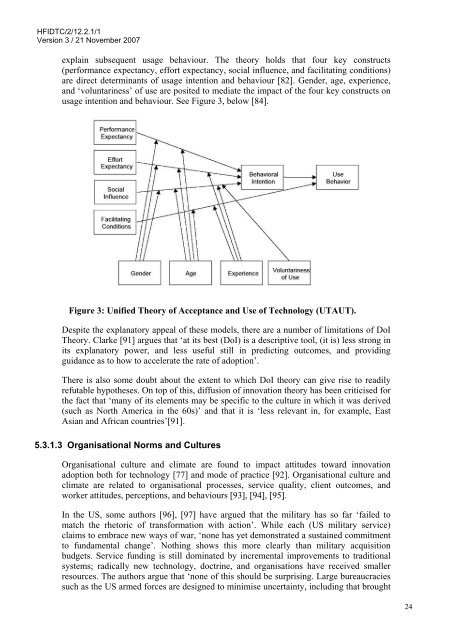The Impact of Technology Insertion on Organisations
The Impact of Technology Insertion on Organisations
The Impact of Technology Insertion on Organisations
You also want an ePaper? Increase the reach of your titles
YUMPU automatically turns print PDFs into web optimized ePapers that Google loves.
HFIDTC/2/12.2.1/1<br />
Versi<strong>on</strong> 3 / 21 November 2007<br />
explain subsequent usage behaviour. <str<strong>on</strong>g>The</str<strong>on</strong>g> theory holds that four key c<strong>on</strong>structs<br />
(performance expectancy, effort expectancy, social influence, and facilitating c<strong>on</strong>diti<strong>on</strong>s)<br />
are direct determinants <str<strong>on</strong>g>of</str<strong>on</strong>g> usage intenti<strong>on</strong> and behaviour [82]. Gender, age, experience,<br />
and ‘voluntariness’ <str<strong>on</strong>g>of</str<strong>on</strong>g> use are posited to mediate the impact <str<strong>on</strong>g>of</str<strong>on</strong>g> the four key c<strong>on</strong>structs <strong>on</strong><br />
usage intenti<strong>on</strong> and behaviour. See Figure 3, below [84].<br />
Figure 3: Unified <str<strong>on</strong>g>The</str<strong>on</strong>g>ory <str<strong>on</strong>g>of</str<strong>on</strong>g> Acceptance and Use <str<strong>on</strong>g>of</str<strong>on</strong>g> <str<strong>on</strong>g>Technology</str<strong>on</strong>g> (UTAUT).<br />
Despite the explanatory appeal <str<strong>on</strong>g>of</str<strong>on</strong>g> these models, there are a number <str<strong>on</strong>g>of</str<strong>on</strong>g> limitati<strong>on</strong>s <str<strong>on</strong>g>of</str<strong>on</strong>g> DoI<br />
<str<strong>on</strong>g>The</str<strong>on</strong>g>ory. Clarke [91] argues that ‘at its best (DoI) is a descriptive tool, (it is) less str<strong>on</strong>g in<br />
its explanatory power, and less useful still in predicting outcomes, and providing<br />
guidance as to how to accelerate the rate <str<strong>on</strong>g>of</str<strong>on</strong>g> adopti<strong>on</strong>’.<br />
<str<strong>on</strong>g>The</str<strong>on</strong>g>re is also some doubt about the extent to which DoI theory can give rise to readily<br />
refutable hypotheses. On top <str<strong>on</strong>g>of</str<strong>on</strong>g> this, diffusi<strong>on</strong> <str<strong>on</strong>g>of</str<strong>on</strong>g> innovati<strong>on</strong> theory has been criticised for<br />
the fact that ‘many <str<strong>on</strong>g>of</str<strong>on</strong>g> its elements may be specific to the culture in which it was derived<br />
(such as North America in the 60s)’ and that it is ‘less relevant in, for example, East<br />
Asian and African countries’ [91].<br />
5.3.1.3 Organisati<strong>on</strong>al Norms and Cultures<br />
Organisati<strong>on</strong>al culture and climate are found to impact attitudes toward innovati<strong>on</strong><br />
adopti<strong>on</strong> both for technology [77] and mode <str<strong>on</strong>g>of</str<strong>on</strong>g> practice [92]. Organisati<strong>on</strong>al culture and<br />
climate are related to organisati<strong>on</strong>al processes, service quality, client outcomes, and<br />
worker attitudes, percepti<strong>on</strong>s, and behaviours [93], [94], [95].<br />
In the US, some authors [96], [97] have argued that the military has so far ‘failed to<br />
match the rhetoric <str<strong>on</strong>g>of</str<strong>on</strong>g> transformati<strong>on</strong> with acti<strong>on</strong>’. While each (US military service)<br />
claims to embrace new ways <str<strong>on</strong>g>of</str<strong>on</strong>g> war, ‘n<strong>on</strong>e has yet dem<strong>on</strong>strated a sustained commitment<br />
to fundamental change’. Nothing shows this more clearly than military acquisiti<strong>on</strong><br />
budgets. Service funding is still dominated by incremental improvements to traditi<strong>on</strong>al<br />
systems; radically new technology, doctrine, and organisati<strong>on</strong>s have received smaller<br />
resources. <str<strong>on</strong>g>The</str<strong>on</strong>g> authors argue that ‘n<strong>on</strong>e <str<strong>on</strong>g>of</str<strong>on</strong>g> this should be surprising. Large bureaucracies<br />
such as the US armed forces are designed to minimise uncertainty, including that brought<br />
24

















